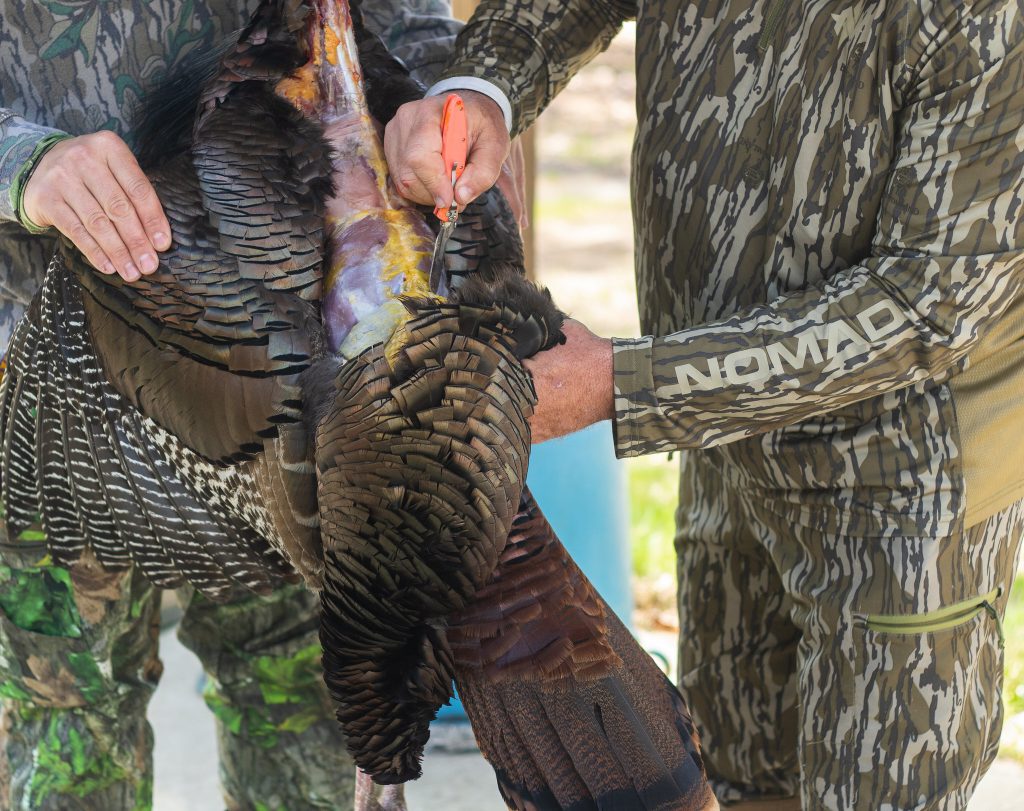As Thanksgiving approaches you may be planning to cook up a tasty turkey dinner for your family and friends. But before carving into that bird on the big day have you ever considered preserving your turkey in all its glory by mounting it? Mounting the turkey can make for an impressive centerpiece for your Thanksgiving table, and an even more impressive decoration that will last for years to come.
I know the idea of mounting an actual dead animal may seem daunting, but it is a surprisingly straightforward process that anyone can do at home with just a few key supplies. In this step-by-step guide, I’ll walk you through everything you need to know to DIY mount your turkey for display. From preparation to posing and setting, you’ll be ready to memorialize your holiday bird in no time.
Supplies You’ll Need
Before getting started, you’ll want to gather the following supplies:
- Turkey – Make sure it’s uncooked and not stuffed, with the legs tied together. A 10-15 lb turkey is ideal.
- Salt – Table salt or canning salt. This will be used to draw moisture out of the turkey.
- Borax powder – Used along with the salt to preserve the turkey.
- Cotton balls or cotton rags
- Trash bags
- Wire
- Cardboard or thin plywood
- Reference photos of turkeys
- Polyurethane foam taxidermy form – Shaped like a turkey body. Check taxidermy supply stores.
- Artificial turkey feet – Optional. Can find online or at craft stores.
- Acrylic paints
- Clear acrylic spray
Gather all of these before getting started on the mounting process. Having the supplies ready ahead of time will make the process smoother
Step 1: Prepare the Turkey
First, remove any innards from the turkey cavities. Rinse the turkey under cold water and pat dry completely with paper towels. Make sure there is no moisture left on the skin or in the cavities.
Next, prop the legs open using twine or skewers so they remain fixed in an open, standing position. Place cotton balls or rags into the turkey cavities to help absorb moisture.
Mix together equal parts salt and borax powder – about 2 cups of each should suffice. Liberally sprinkle the salt-borax mixture all over the turkey, inside and out. Get into every nook and cranny. The mixture will draw out moisture from the turkey tissues.
Place the turkey on a few layers of paper towels lined inside a trash bag. Tie the bag closed. Place in the refrigerator for 5-7 days, replacing the paper towels daily as they absorb liquid. The turkey is ready when the meat feels firm throughout.
Step 2: Pose the Turkey
Once the turkey is firmed up through the salting process, it’s time to pose it. Posing gives your mount a lifelike position.
Study reference photos of live turkeys standing tall with wings spread, heads upright and tails fanned. Recreate a pose like this with your turkey.
Bend the legs into a proper standing position using the internal wires or skewers. Use additional wires inserted into the wings, tail and neck to support the turkey parts and hold the pose.
Ensure the wings are symmetrically spread, the tail is upright and fanned, and the neck/head are straight. Check photos from different angles to perfect the posing.
Step 3: Mount the Turkey to the Form
With the turkey fully posed, it can now be mounted onto the taxidermy body form. Start by placing the form inside the abdominal cavity, with the neck attached up through the chest and out the neck hole.
Use pins or needles to pin the turkey’s skin onto the form, attaching the wings, legs, and facial features directly onto the form beneath. The skin should stretch tautly over the form.
Take your time and check angles as you work to ensure proper proportions and symmetry. Make adjustments as needed.
Once fully mounted, tie the body form and turkey tightly together with twine or wire, wrapping underneath the breast area and around the backside. The turkey should now be secured upright on the mounted form.
Step 4: Let the Mount Dry
With the turkey mounted onto the form, it needs time to fully dry and set. Place the whole mount on a drying rack or board, propping it upright.
Let the mount dry in a well-ventilated area out of direct sunlight for 2-3 weeks. This gives all the moisture time to evaporate completely so it can hold its shape.
Check regularly and dab away any beads of oil that rise to the surface as the turkey dries out. Keep the position adjusted properly while drying.
Step 5: Apply Finishings
Once fully dried, your turkey mount is ready for any final finishings.
Use acrylic paints to touch up the feet, beak, wattle and any imperfections on the skin. Blend well so the paint isn’t noticeable. Add glass eyes if desired for a realistic effect.
Brush a thin layer of clear acrylic sealer all over the turkey to protect and seal the surface. Let the sealer fully dry and apply a second coat for best results.
Your turkey is now ready for display! Position it on your Thanksgiving table for a showstopping decor focal point. Or find a prominent place to proudly put your mounted turkey on year-round display.
Turkey Mounting Tips and Tricks
-
Work in a cool area to prevent skin decay while mounting the turkey.
-
Be extremely gentle when handling the posed turkey to avoid tearing the dried skin.
-
Wear gloves during the salting process to keep the salt from drying out your hands.
-
Use borax substitute if you want to avoid using borax powder.
-
Opt for a wire form over rigid cardboard or wood for more flexibility in posing.
-
Reference color photos of live turkeys if painting feet, beak etc for realistic colors.
-
Consider artificial turkey feet for a more lifelike appearance.
-
Ensure the drying area is fully ventilated and free of insects.
-
Check for and remove maggots if they begin growing in the flesh while drying.
Display Your Mount with Pride
And that’s it – follow these steps and you can preserve your prized turkey in a lifelike mount to enjoy for years to come. From brining to posing and drying, you’ll gain a true sense of accomplishment seeing your holiday bird immortalized in all its glory.

Whether it was your first gobbler, one that was from a memorable trip with family and friends or maybe you were even lucky enough to hunt a Gould’s or Ocellated, there are many reasons that you may consider taxidermy.
If you do plan on getting your bird mounted, there are some tips you should know ahead of time.
First, it’s good to schedule with a taxidermist before your hunt, so all logistics can be arranged accordingly, allowing you to get your bird there as smoothly and hassle-free as possible. This is especially true if you plan to use a taxidermist out of state. Since this could be the bird of a lifetime, it would also behoove you to use a taxidermist specializing solely in turkeys.
“Ive seen a lot of good taxidermists over the years that do a lot of different animals but specialize in maybe one of them,” said John Beard, 27-year taxidermy veteran and the NWTF’s 2019 Grand National Champion in the Master of Masters turkey division. “From my experience, that guarantees you quantity but costs you quality. I do not want quantity, I want quality. I recommend finding someone who specializes in your species to be mounted. For turkey, find a turkey guy. For deer, find a deer guy. For duck, find a duck guy.”
In addition to finding a taxidermist that solely focuses on turkeys, Beard offered some other tips when looking for a taxidermist.
“If they dont have any current work in their shop, then that is a red flag,” said Beard. “If they do have current work and you like their quality and price, then you found your taxidermist.”
What separates well-done taxidermy from poorly done is how life-like the bird looks, longevity of the mount and overall quality of the finished product, and to ensure these attributes, there are a couple of things you should remember when bringing a bird back from the field.
“The most talked about process I explain to hunters on how to ensure their birds get back to me in good shape for taxidermy is, first and foremost, cut nothing; do not get breast meat out,” said Beard. “I want the bird whole as needed for the taxidermy process.”
(Hunters wishing to keep meat and have the bird mounted can follow steps for “prepping a bird from outside the U.S.”)

Prepping a turkey for your taxidermist
Beard suggests doing the following with your harvest for the best taxidermic product:
- Bring three paper towels folded up in a sandwich bag with a roll of black electrical tape and one large black trash bag. All this easily folds up and compacts perfectly into a hunting vest.
- Right after harvest, immediately get on the bird and prevent him from flopping and causing feather loss and damage.
- Once the bird is dead, take out the three paper towels, stick one down the birds throat and use the other two to wrap around the head, and then cover all that with the sandwich bag and seal with tape.
- Place the bird head first in the large trash bag, and then get it to the taxidermist as soon as possible or freeze it immediately.
How To Mount A Turkey Fan * THE EASY WAY *
FAQ
What to do with a turkey if you want to mount it?
Where do you shoot a turkey for mounting?
